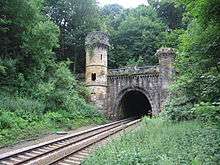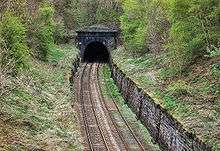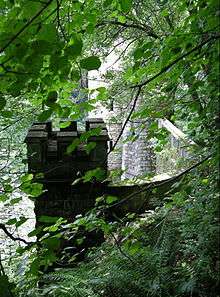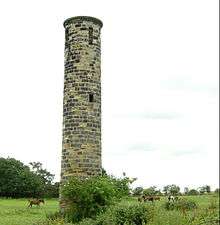Bramhope Tunnel
 Bramhope Tunnel north portal | |
| Overview | |
|---|---|
| Line | Harrogate Line |
| Location | Horsforth–Weeton |
| Coordinates | 53°53'23"N. 1°36'45"W. |
| Operation | |
| Work begun | 1845 |
| Opened | 1849 |
| Owner | Network Rail |
| Operator | Northern |
| Technical | |
| Length | 2.138 miles (3.441 km)[1] |
| Track gauge | Standard gauge; double track |
| Operating speed | 60 miles per hour (97 km/h) |
| Tunnel clearance | 25 feet (7.6 m) |
| Grade | 1 in 94 (0.01%) |
The Bramhope Tunnel is a railway tunnel 2.138 miles (3.441 km) long, owned by Network Rail on a route currently operated mainly by Northern. It was constructed during 1845–1849 on the Harrogate Line, carrying rural and commuter passengers between Horsforth and Arthington in West Yorkshire, England. It is notable for its length, for its crenellated north portal, which is Grade II listed, and for the deaths of 24 men during its construction, commemorated in Otley churchyard with a castellated replica of the north portal.
It was constructed by Thomas Grainger, engineer and James Bray, overseer, who set up two sighting towers and then twenty shafts along the line of the tunnel. Men dug horizontally from these shafts until the diggings joined up in 1848. Thousands of navvies lived locally in bothies with their families, and dug in dangerous and wet conditions to facilitate the grand opening in 1849.
History

The tunnel was first proposed in 1843 with an estimate of £800,000 approved in 1845, though the final cost by 1849 was £2,150,313 (equivalent to £201,170,000 in 2015)[2] and the lives of 24 men. Thomas Grainger[3] was the engineer and James Bray was the contracted overseer in 1845 for the construction of the Horsforth–Arthington tunnel under Bramhope and the ridge between Airedale and Wharfedale. Bray was a Leeds iron and brass founder, and previously constructed the Thackley Tunnel, Bradford.[4]
Two sighting towers were built for the engineers to keep the line true, then from 20 October 1845 twenty shafts were sunk to enable access for tunnelling. Tunnelling started after the foundation stone was laid at the bottom of No. 1 airshaft in July 1846. The separate diggings first joined up into one long tunnel on 27 November 1848, and it was completed in summer 1849.[4]
The southern entrance or portal is usually described as plain, but is admired by some. The north portal is castellated, and after it was finished was lived in for a while by railway workers. The north portal was listed Grade II in 1988.[3] The finished tunnel is 2 miles, 243 yd or 2.138 miles (3.441 km) long; 25.5 feet (7.8 m) wide by 25 feet (7.6 m) high. It is a double track tunnel, with a gradient of 1 in 94 (0.01%) down from Horsforth to Arthington and at its deepest point, just to the north of Breary Lane, it is 290 feet (88 m) below the surface. The construction was for the Leeds Northern Railway and the East and West Yorkshire Junction Railway, which together later became the North Eastern Railway. The grand opening was 9 July 1849, but the first train went through on 31 May in the same year, full of Leeds and Thirsk railway officials, and pulled by Bray's locomotive Stephenson.[4]
Working conditions

There were possibly up to 2,300 navvies plus their families, with 400 horses brought in for the work. That is said to include 188 quarrymen, 102 stonemasons, 732 tunnel men, 738 labourers and 18 carpenters. For four years they lived in 200 wooden bothies with their families in a field opposite Bramhope cemetery, alongside offices and workshops. There were 100 more bothies elsewhere along the line of the tunnel. Day– and night–shifters were said to take turns to use the beds, as was normal for sailors of the time. However, sailors had their own bedding to unroll onto the bare bunk or hammock, whereas many navvies may have had little of their own. This tunnel was built at the height of the Hungry Years, and many poor Irish refugees were working on the railways.[4]
Many of the navvies were farm labourers from the Yorkshire Dales, North East England, East Anglia and the Fenlands as well as from Scotland and Ireland. Men were lowered by bucket down the airshafts to dig by candlelight. They were paid £1.50 per week to shovel 20 tons (20.32 tonnes) of rock and earth per 12–hour shift, seven days a week. Conditions were constantly wet, with foul air and gunpowder fumes plus the danger of roof–collapse.[4] This was because the tunnel cuts through hard sandstone, shale and clay, and there are seven major faults in the rock near the centre point.[5] Metal sheets had to be used to divert water inside the tunnel. A public waterworks scheme with reservoirs and aqueduct was proposed but not implemented.[6]
Human cost

The work was dangerous because the rock at the Horsforth end was difficult to blast, and there was frequent flooding and subsidence. It is suggested that up to 1,563,480,000 gallons (7,107,580,080 litres) of water were pumped out between 1845 and 1849. Five men died in 1846; 12 died in 1847; seven more had died by 1849, making 24 in total. In Otley churchyard is a monument in the shape of the north portal, dedicated to the 24 men who lost their lives. Records of death and injury were kept from 1847 to 1849, and Leeds Infirmary had a special spring cart to ferry the injured to hospital from the site to Leeds.[4]
The sadness of the harsh conditions of those days is captured by the simple epitaph on the gravestone of James Myers who is buried in the Methodist Cemetery at Yeadon behind the Town Hall. James was a married man just 22 years old who 'died by an accident in the Bramhope Tunnel on the 14th day of April, 1848'. Next to him lies the body of his 3 years old daughter who died two weeks later of some unspecified illness. Cllr Philip Sunderland[4]
Alcohol and water

Drunkenness and fighting was such that Jos Midgeley, a railway police inspector, was hired for £1.25 per week to keep order. At one time he was attacked by a group of men, and at another there was a riot at Wescoe Hill in which a man died, all because the contractors tried to cut off the beer supply.[4]
Water was taken at first from Bramhope's town well, opposite St Giles Church, but the excessive demand diminished the supply and spoiled the quality. The tunnellers' water was then pumped from a site near the Dyneley Arms crossroads. But at the same time the tunnel itself was draining away the local farmers' natural irrigation, and the source of Bramhope town well. Litigation on this subject continued for some years.[4]
Education and religion
The number of workers' children overwhelmed that of the local children in Bramhope's school – however this was before the Elementary Education Act 1870 which provided for education for all, up to the age of 12 years.[7] Poor children would have been educated at the parochial school in Eastgate, where the memorial gardens are now.[8] The workers and their families attended St Ronans Methodist chapel at Bramhope, and the Methodist chapel at Pool-in-Wharfedale. The Leeds Mission spread Bibles and tracts in the shanty–town.[4]
What is visible today

Four of the twenty shafts remain as ventilation shafts. These are: the first to the north of the Leeds–Otley A660 near the Scout hut in Bramhope; the second behind Park House, Bramhope; the third opposite Camp House Farm and the fourth near Cookridge and Horsforth. The ventilation shafts measure 40 feet (12 m) by 30 feet (9.1 m) – wider than the tunnel itself.[5] One of the two sighting towers remains, in the field opposite Bramhope cemetery. It is a tall, cylindrical structure, two metres in diameter with four vertical slits near the top and flat coping stones. The coursed sandstone tower is a grade II listed structure.[9] The other one, now demolished, was behind Dyneley Hall. 250,000 cubic yards (190,000 m3) of spoil still lies along the line of the tunnel. One of a number of tips is in an area around the scout hut to the north of the Leeds–Otley road; a second is the Knoll near to Parklands and on to the field facing Bramhope cemetery; a third is on land adjacent to None–Go–Byes Farm.[4]
North and south portals

The listed southern portal is a plain sandstone horseshoe-shaped arch with rusticated voussoirs below a cornice and parapet.[10] It is approached by a slightly curved 300-metre cutting faced with retaining walls of sandstone. The listed walls have a concave batter, slightly-projecting piers at regular intervals and are topped with square coping stones.[11]
The Gothic north portal was said to have been built to please the landowner William Rhodes,[12] who wanted to use one of the towers as a belvedere. It is built of rock–faced sandstone and has three side towers with turrets, and a horseshoe–shaped archway. The keystone features a portrait of a bearded man who is said to resemble the aforesaid landowner. There is a crenellated parapet with a carved cartouche in the centre featuring a wheatsheaf, fleece and fish.[3]
Both portals are on Network Rail land with no public access.[13]
Accident
A southbound passenger train and a pilot engine left Arthington station on 19 September 1854 heading for Leeds. A pilot engine had travelled northbound through the tunnel earlier the same day with no problems but this time the train ran into a pile of stone debris and was derailed when it was three-quarters of the way into the tunnel. The debris was from a roof fall that affected both tracks. The train engine collided with the pilot engine tender causing considerable damage.[14]
Recent repairs
Trains have been cancelled or delayed frequently in recent years, due to flooding in the Bramhope Tunnel. Water still runs fast into the tunnel, and in the 1960s a train was derailed by a 3-ton (3.3 tonne) icicle.[6] Major repair work was done in 2003 and 2006, with the Victorian drainage culvert replaced, and the track lowered to allow larger passenger and freight stock, costing £10 million.[15][16] The sixteen closed airshafts were deteriorating and had to be re-capped.[17] In 2003 the excavated material from the works was recycled to shore up the railway embankment near Castley.[18]
References
- ↑ "Locomotive Railway Carriage & Wagon Review". Volume 35: The Bramhope Tunnel, L.N.E. Ry. 172. illus. (and Supplement). 1929. Retrieved 2 April 2010.
- ↑ UK CPI inflation numbers based on data available from Gregory Clark (2016), "The Annual RPI and Average Earnings for Britain, 1209 to Present (New Series)" MeasuringWorth.
- 1 2 3 "Bramhope Tunnel: Grade II listing, 1988, with description". English Heritage National Monuments Record. Retrieved 19 July 2009.
- 1 2 3 4 5 6 7 8 9 10 11 Sunderland, Cllr Philip. "Bramhope Tunnel". Bramhope Parish Council. Archived from the original on 27 April 2009. Retrieved 14 July 2009.
- 1 2 "Bramhope Tunnel". Engineering Timelines. 2009. Retrieved 19 July 2009.
- 1 2 "Tunnel vision was such a drain on cash and life: from the Telegraph & Argus, first published Thursday 4th Sep 2003.". Bradford & District archive. Retrieved 2 April 2010.
- ↑ "Internet Archive". Full text of "The Elementary Education Act, 1870, with introduction, notes, and index, and appendix containing the inforporrated statutes". Shaw & Sons, Fetter Lane, London. 1870. Retrieved 2 April 2010.
- ↑ Seals, W.F. (10 October 2000). "Bramhope.org (Bramhope & Carlton Parish Council)". A Brief History of Bramhope (source: "A History of the Township of Bramhope"). Retrieved 2 April 2010.
- ↑ "Sighting Tower". English Heritage . Retrieved 8 July 2014.
- ↑ "Portal to south entrance of Bramhope railway tunnel". English Heritage. Retrieved 8 July 2014.
- ↑ "Retaining walls of railway cutting extending southwards from south portal of Bramhope tunnel". English Heritage. Retrieved 8 July 2014.
- ↑ "Leeds to Harrogate 1849 – Present North Eastern Railway". Lost Railways West Yorkshire. Retrieved 19 July 2009.
- ↑ The north portal can be seen at a distance from the nearby public footpath, and glimpsed from the Leeds–bound train when entering the tunnel. The south portal has no public access as it is in a cutting with no easy viewing point, and is quite difficult to glimpse from a train, which can now go through at 60 miles per hour (97 km/h).
- ↑ "Accident Returns: Extract for the Accident at Bramhope Tunnel on 19th September 1854". Railway Archive. Retrieved 8 July 2014.
- ↑ "Rail tunnel to close for £10m revamp". BBC News. 14 July 2003. Retrieved 19 July 2009.
- ↑ Wilder, Peter. "Renewal of the Bramhope Tunnel, Network Rail" (PDF). Pandrol Fastclip. Retrieved 19 July 2009.
- ↑ "Bramhope Tunnel repairs on the right track". Tarmac. January 2007. Retrieved 19 July 2009.
- ↑ "Use of recycled ballast as fill to embankment on a railway". Wrap. 5 April 2005. Retrieved 19 July 2009.
| Wikimedia Commons has media related to Bramhope Tunnel. |
Coordinates: 53°53′23″N 1°36′45″W / 53.88972°N 1.61250°W